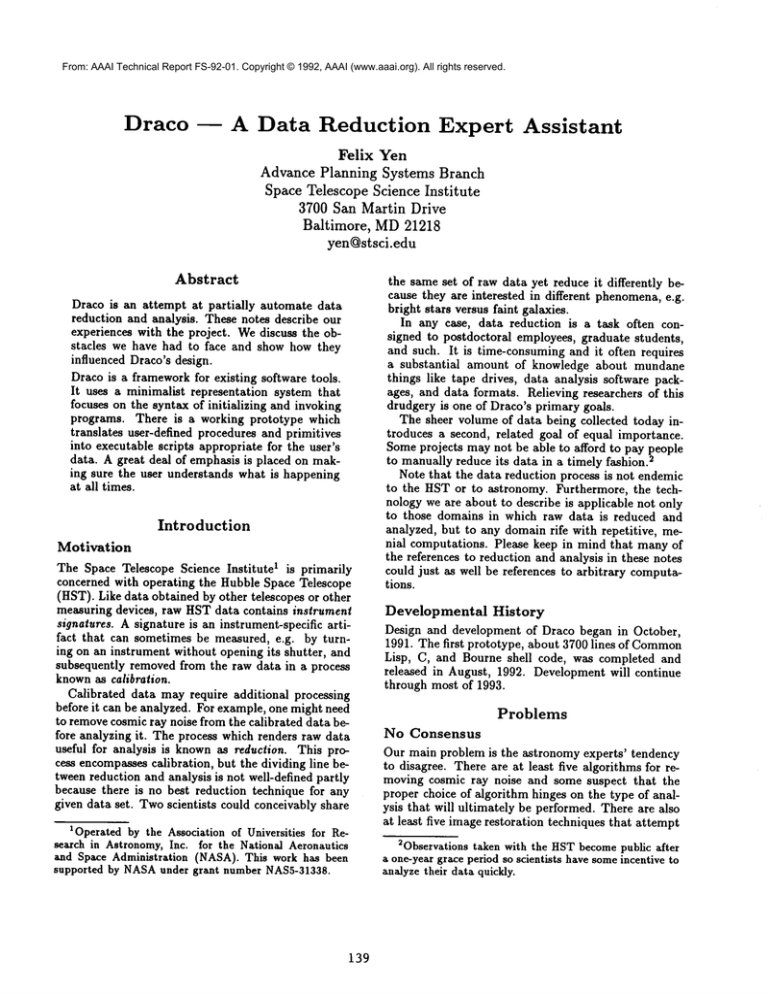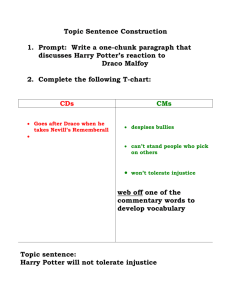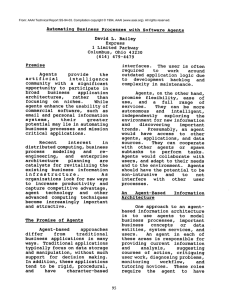
From: AAAI Technical Report FS-92-01. Copyright © 1992, AAAI (www.aaai.org). All rights reserved.
Draco
A Data Reduction
Expert
Assistant
Felix
Yen
Advance Planning
Systems Branch
Space Telescope Science Institute
3700 San Martin Drive
Baltimore,
MD 21218
yen@stsci.edu
Abstract
Draco is an attempt at partially automate data
reduction and analysis. These notes describe our
experiences with the project. Wediscuss the obstacles we have had to face and show how they
influenced Draco’s design.
Draco is a frameworkfor existing software tools.
It uses a minimalist representation system that
focuses on the syntax of initializing and invoking
programs. There is a working prototype which
translates user-defined procedures and primitives
into executable scripts appropriate for the user’s
data. A great deal of emphasis is placed on making sure the user understands what is happening
at all times.
Introduction
Motivation
The Space Telescope Science Institute 1 is primarily
concerned with operating the Hubble Space Telescope
(HST). Like data obtained by other telescopes or other
measuring devices, raw HSTdata contains instrument
signatures. A signature is an instrument-specific artifact that can sometimes be measured, e.g. by turning on an instrument without opening its shutter, and
subsequently removed from the raw data in a process
knownas calibration.
Calibrated data may require additional processing
before it can be analyzed. For example, one might need
to removecosmic ray noise from the calibrated data before analyzing it. The process which renders raw data
useful for analysis is known as reduction. This process encompassescalibration, but the dividing line between reduction and analysis is not well-defined partly
because there is no best reduction technique for any
given data set. Twoscientists could conceivably share
I Operated by the Association of Universities for Reseaxch in Astronomy, Inc. for the National Aeronautics
and Space Administration (NASA). This work has been
supported by NASAunder grant number NAS5-31338.
139
the same set of raw data yet reduce it differently because they are interested in different phenomena,e.g.
bright stars versus faint galaxies.
In any case, data reduction is a task often consigned to postdoctoral employees, graduate students,
and such. It is time-consuming and it often requires
a substantial
amount of knowledge about mundane
things like tape drives, data analysis software packages, and data formats. Relieving researchers of this
drudgery is one of Draco’s primary goals.
The sheer volume of data being collected today introduces a second, related goal of equal importance.
Someprojects may not be able to afford to pay people
2to manually reduce its data in a timely fashion.
Note that the data reduction process is not endemic
to the HSTor to astronomy. Furthermore, the technology we are about to describe is applicable not only
to those domains in which raw data is reduced and
analyzed, but to any domain rife with repetitive, menial computations. Please keep in mind that many of
the references to reduction and analysis in these notes
could just as well be references to arbitrary computations.
Developmental
History
Design and development of Draco began in October,
1991. The first prototype, about 3700 lines of Common
Lisp, C, and Bourne shell code, was completed and
released in August, 1992. Development will continue
through most of 1993.
Problems
No Consensus
Our main problem is the astronomy experts’ tendency
to disagree. There are at least five algorithms for removing cosmic ray noise and some suspect that the
proper choice of algorithm hinges on the type of analysis that will ultimately be performed. There are also
at least five image restoration techniques that attempt
2Observations taken with the HSTbecomepublic after
a one-yeargrace period so scientists have someincentive to
analyze their data quickly.
From: AAAI Technical Report FS-92-01. Copyright © 1992, AAAI (www.aaai.org). All rights reserved.
to compensate for the HSTprimary mirror’s spherical
aberration. Scientists often wish to experiment with
different algorithms in order to discover which ones
are best suited for their data.
Neither the older paradigm of procedurally encoding domain knowledge or the newer expert systems
paradigm are well suited to supporting this sort of
experimentation. Furthermore, both paradigms suffer
from other problems. For example, procedurally encoded systems can be extremely difficult to maintain
because a single fact about the domain may be encoded in several places. On the other hand, rule-based
expert systems can also be difficult to maintain because
one finds that the individual facts, when placed in a
domain-independent framework, often interact in unexpected ways. There is also the well-publicized knowledge acquisition bottleneck, i.e. determining what the
factsareand whenonehas accumulated
enoughfacts.
The problemcouldbe summedup as follows:the
ground-breaking
scientist
is oftenunsureaboutwhat
thefactsreally
are.Theconventional
approaches,
including
theexpertsystems
approach,
do notworkwell
in sucha domain.
We feelthatAI technology
canstill
provide
a solution.
Inertia
A scientist has good reason to be skeptical of new software claiming to replicate the functionality provided
by his current analysis software package, especially
since his package has probably earned not only his respect but that of his peers. Astronomers are particularly concerned with understanding how their data is
being manipulated. This inertia, along with our limited project resources, convinced us that we needed to
design a system that can use existing reduction software, and the astronomer’s concern for his data convinced us that our system must be able to assure the
user that the proper reduction steps have been carried
out.
Heterogeneity
& Antiquity
There are manysoftware tools including several widelyused analysis packages and several data file formats.
Integrating all these tools in a single frameworkwill
not be easy, especially since few of these tools were
designed with this sort of integration in mind. These
tools must eventually be replaced by a single, coherent, extensible analysis package, but integrating existing packages seems to be the most appropriate solution
today.
Solutions
Overview
Wemake two observations. First, our goal is to optimize a man-machine system of scientists,
software
developers, and software. The system’s purpose is to
collect, reduce, and subsequently analyze data. The
140
traditional
software
engineer
attempts
to optimize
the
software
partof thesystem,
i.e.makethesoftware
as
powerful
as possible.
Thisdoesnotnecessarily
optimizethesystemas a whole(butit is a goodway to
stayemployed).
Giventheflexibility
required
by our
domain,
we feelthatourefforts
wouldbe better
spent
developing
software
whichis notknowledgeable
in the
sensethatit doesnotanticipate
userdemands.
What
itdoesdo isallowtheusertoeasily
adapthissoftware
to thesituation
at hand.In short,Dracois notan
expert
system,
butan environment
thatfacilitates
the
integration
ofexisting
software
tools.
Oursecondobservation:
purelysyntactic
manipulationsareoftenquiteuseful.
Dracocanbe likened
to
an algebra or a programming language. One defines
a set of primitives and is allowed to combine them to
form procedures. Draco does not know anything about
the semantics of the primitives, but it does knowwhich
combinations of primitives are syntactically valid, and
therefore potentially useful. The user is responsible for
insuring that the procedures are truly useful.
Procedures and primitives are abstract entities. The
user provides additional information about concrete
entities such as primitive implementations and the data
formats corresponding to these implementations and
Draco uses this information to translate a procedure
into an executable script tailored to the user’s data.
Keeping
the
User
Informed
In order to keep the user at ease, we have made every
effort to generate an audit trail as the reduction proceeds. The trail begins with an inventory of the user’s
data files. This file inventory is generated by a collection of file type recognizers and reporters. In practice,
these recognizers are very thorough; they often read
the file in order to determine its type. A sample file
inventory is given in Figure 1.
An executable script should produce a log file recording the data reduction or analysis steps performed.
Once again, Draco does not know how to produce such
a log file; it merelyprovides a little syntax enabling the
user to define his entities so that appropriate entries
will be entered in the log.
Integrating
Existing
Packages
Dependingon the packages, i.e. if they all have fairly
reasonable command-lineinterfaces, this can be a surprisingly easy task. Draco makes do simply by storing
a character string template for each of the user’s tools.
For example, a user might define a primitive RCRN
(Remove Cosmic Ray Noise) as in Figure
RCRNis defined in terms of its input data type
image-set, its output data type image, and the implementations list following the :concrete keyword. The
:reconcile keyword determines how multiple inputs are
to be handled. The default value nilspecifies that multiple inputs should signal an error condition, a value of
From: AAAI Technical Report FS-92-01. Copyright © 1992, AAAI (www.aaai.org). All rights reserved.
Figure 1: Samplefile inventory
Figure 2: Sample primitive specification
Inventoryfor/marian/data2/mds
Generated on 02-Aug-1992, 16:32:16
Draco version: 1
GEIS-CALIB-IMAGEfiles
(define-primitive
:name
:documentation
:input
:reconcile
:output
:concrete
-
w0ulld03t.c0h
=
FILETYPE: ’SCI
IMAGETYP: ’EXTERNAL
INSTRUME: ’WFPC
FILTNAMI: ’F555W
FILTNAM2: ’
w0ulla04t.c0h
=
FILETYPE: ’SCI
IMAGETYP: ’EXTERNAL
INSTRUME: ’WFPC
FILTNAMI: ’F785LP
FILTNAM2: ’
DIRECTORYfiles
uparm:
)
Figure3: Sampleimplementation
specification
(define-implementation
:name
STSDAS-RCRN
:documentation
"a CR removalprogram"
:draco-package
IRAF
:input
IRAF-image-list
:output
GEIS-calib-image
:initialize-once
("stsdas"
"wfpc"
"combine.logfile=\ "-log\"")
:initialize
("combine.usedqf=yes"
"combine.outtype=r"
"combine.option=\ "crreject V’ ")
:syntax
"combine @-in -out"
directory
UNIXfiles Draco.inv:
mbox:
RCRN
"remove cosmic ray noise"
image-set
:distributive
image
(STSDAS-RCRN)
Draco document
mailfolder
)
conjunctive specifies that the corresponding implementation should process all inputs at once, whereas the
value in the example, :distributive, specifies that the
implementation should be invoked once for each input.
One popular way of removing cosmic ray noise is
to take several exposures and then average their pixel
values ignoring those which are unusually bright. The
3 program wfpc.combine 4 can be used to perSTSDAS
form this reduction step.
The implementation
STSDAS-RCRN
(Figure 3)
defined in terms of its analysis package IRAF5, its
input file type IRAF-image-list, its output file type
GEIS-calib-image ~, its initialization
commandtemplates, and a template specifying its invocation syntax.
In these templates, "-in" represents the implementation’s input, "-out" represents its output, and "-log"
represents the log file to be generated.
aSTSDAS= Space Telescope Science Data Analysis
System
4WFPC= Wide Field/Planetary
Camera
5STSDAS
is layered on the Image Reduction and Analysis Facility.
6The STSDAS
data file format is knownas the Generic
Edited Information Set.
141
An implementation need not be part of a software
package. Stand-alone UnixTM programs and Common
Lisp functions may also be used to implement primitives.
Conclusions
At this point, it should be clear that our initialization
and invocation templates have trivialized the problem
of automatically generating calls to existing reduction
programs. The moral of our story appears to be that
one need not accumulate vast amounts of declarative
knowledgein order to create a useful "expert system,"
even (especially?) if one’s domain experts frequently
disagree with each other.
The first Draco prototype demonstrates that one
only needs a minimalist representation system to harness existing data reduction tools. Instead of undertaking the costly enterprise of declaratively encoding
algorithms and other techniques, e.g. iterative image deconvolution methods, we have made use of the
vast amount of procedurally-encoded domain knowledge that already exists.
From: AAAI Technical Report FS-92-01. Copyright © 1992, AAAI (www.aaai.org). All rights reserved.
Future
Directions
Our code generation problem would be much more difficult if our procedures had more structure. Data reduction procedures tend to be pipelines of programs
that do little more than read data and write transformed data. More complex procedures might invoke
predicates to control branching or looping. Draco
would have to undergo substantial changes if it is to
support additional procedural complexity, but these
changes seemto be fairly straightforward, i.e. not challenging from a representational point of view.
One bit of complexity that might be implemented
shortly is the ability to automatically invoke data format conversion programs in order to integrate software
packages that do not share a commondata format.
Once again, this modification does not appear to be
challenging from an AI point of view.
What would be challenging is giving the user the
ability to specify a set of analysis goals and then selecting the procedure most suited to these goals. Such
ambition would require a much richer representation
language, and more time than we can spare.
Acknowledgements
I would like to thank Glenn Miller for his excellent
review of earlier drafts of these notes and for his help
in designing Draco. Mark Johnston also plays a critical
role in this project.
142





